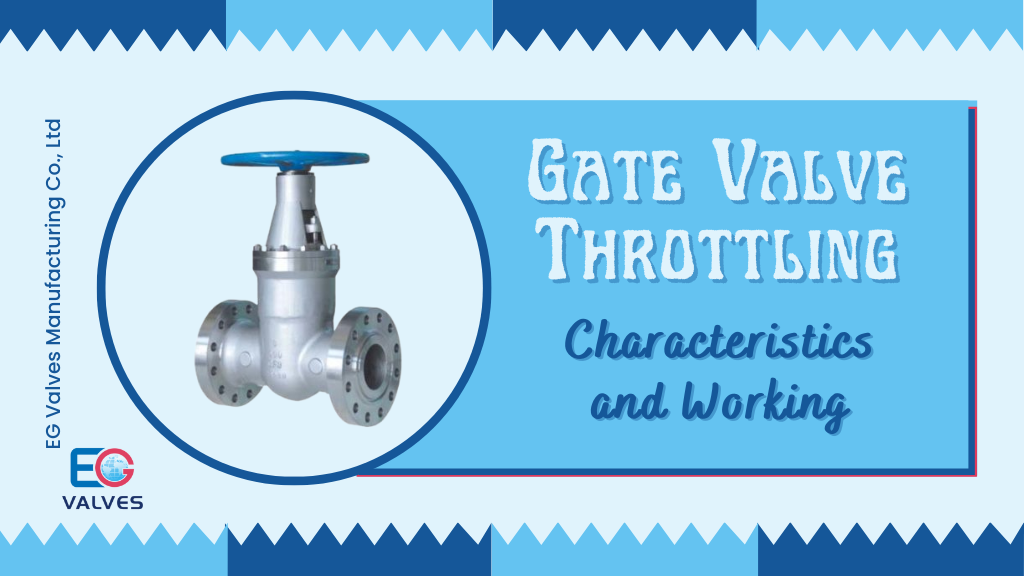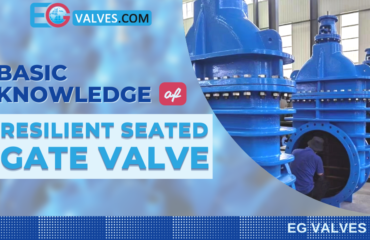
In the Industrial revolution, we recognize that valves have improved our daily life. As a vital mechanical part, valves play a significant role in daily life and industrial development. Valves are engaged to regulate gases and liquid substances by controlling the flow through pipes and other passageways. For example, a door regulates entry at any place, likewise, valves regulate the flow of fluids, gases, or slurries through pipes. To get the best result from a gate valve it is important to select the suitable valve for the service required. There are different variables for selecting the valve. Every valve has different applications and characteristics. Here we will discuss the working and characteristics of gate valve throttling.
When considering service conditions, the foremost step is to classify what type of medium will be handled. Every valve has its own function. Some valves are best suited to control the flow of liquids while others are preferred for gases. If it is a liquid, it is essential to define whether it contains any solid substance. On the other hand, it is important to identify whether the media will remain liquid throughout the flow or it will vaporize and become a gas.
The pressure and temperature are also the main aspects to consider throughout the handling system. This shows what material the valve should be constructed from. For example, at low temperatures, bronze, and stainless steel is required. On the other hand, at extremely high temperatures ceramic or refractory metals are used. The temperature range goes from 150 to 1000 degrees Fahrenheit.
Below mentioned materials are used in this high-temperature range.
- Bronze
- Cast iron
- Carbon Steel
- PVC Plastic
It is important to know the specifications of the valve that is being used. The foremost category of valve functions is on/off or open/close. The only purpose is to start and stop the liquid or gas substance. The best valve designs are gate valves, plug valves, stem valves, ball valves, and disc valves.
Valves are used for tool measurement. Applications of valves are venting, static pressure, absolute pressure, liquid level, and more.
Different Categories of Valves
Gate Valve: Gate valve is the best option for you if you are looking for the most commonly used valve. The main function is to on/off the valve. Gate valve throttling is used as a flow controller. It handles increased flow resistance when closed. They are linear indication valves with a wedge and flat disc into the stream.
Globe Valve: In the industry, they are used to control flow. It is used both for on/off and throttling applications. Globe valves are linear indication valves with a disc and plug attached to the stem that closes onto a surface. It works as a flow control element.
Butterfly Valve: If you want to buy flexible valves opt for butterfly valves. They have a distinct seal ring that seals the valve body to the disc. To completely open the valve, spin the flat disc 90 degrees. To stop the flow, rotate the disc perpendicular to the flow direction. The butterfly valves are employed in the bigger pipe diameter.
Valve has the following contents:
- Casing
- Port
- Stem
- Actuator
- Disc
- Seat
- Gasket
Casing: Casing is the body of the valve.
Port: Port is the opening point of the valve body where the liquid and gas substances enter or leave. It is the inlet and outlet of the valve. A valve can be multi-ported or dual-ported.
Stem: It transfers motion from the handle to the controlling disc.
Actuator: It controls the valve activity.
Disc: Disc is the main element of the valve. It controls the flow of liquids and gases.
Seat: The seat provides a tight seal to the disc.
Gasket: It is used to prevent liquid and gas leakage in the valves.
Valve Maintenance:
- Always check the pressure mark on the vales and port meets your application needs.
- Examine the valves periodically, when stored for future use. The surface of the valve should be clean. In the case of a ball valve, the surface should be stored open. For the gate valve and globe valve, the ports should be stuffed but in a close position.
- Keep the valves in a cool, dry place.
- For the working china gate valve and ball valve make sure the valve is fully open or fully closed.
- Always use the hand wheel method to open and close ball valves, and gate valves. Do not use other tools as they may damage the component. Simply turn the hand wheel counterclockwise to open the valve and clockwise to close the valve.
- To avoid any tear turn the packing gland nuts evenly.
- The stem damage may cause leakage.
- During usage always clean the valves. The screw must be lubricated. When any problem occurs, immediately stop working.
Functioning of a Gate Valve
The working of a gate valve is simple. To open the flow path lift the gate valve. It can be turned manually by a hand wheel. The hand wheel rotates the valve stem and offers a perpendicular movement of the gate. Gates throttling valves are also known as multi-turn valves because of the hand wheel. As the hand wheel needs full one cycle to fully open or to fully close the gate valve.
You can even buy electrically actuated gate valves but these are cost-effective.
Uses of Gate Valves
- Gate valve is one of the most used valves in gas processing plants, chemical plants, and more where pressure remains low, but the temperature is high.
- Gate valves are installed in pipe ways as isolating valves. While operating the valve, the gate moves up or down.
- Gate valves require less maintenance and are suitable for high-pressure temperatures.
Types of Gate Valve
The gates are divided into two types.
-parallel gate valve
-wedge shaped gate vale
In a parallel gate valve, a flat disc gate is used between two parallel seats i.e. upstream and downstream. They are used in low pressure, where tight shutoff is required.
The wedge-shaped gate valve uses two inclined seats and a tight shut-off.
The material used in the gate valve
A lot of materials are used to construct a gate valve. For example cast iron, cast carbon steel, bronze, stainless steel, ductile iron, and more. PVC and brass gate valves are meant for plumbing amenities. According to the design, temperature, and fluid service, the gate valve is constructed.
Method of control
A replaceable disk is a closure element of a gate valve. To open the valve, the disk is completely removed. To close the valve, it needs 360 degrees disk to seal the ring contact surface. Proper closing of a disc ensures there is no leakage across the disk.
Gate Throttling Valve
To regulate the flow in your pipe way, a throttling valve is used. To start or stop the liquid flow or gas element, throttling valves reduce the volume and pressure through the system.
The throttling valve does not require any modifications in its position. It reduces pressure and speed in a piping system. A throttling valve is used to regulate the flow from one point to the second point because there is a higher volume of pressure on one point of the throttle valve with a lower volume of pressure on the other side. To control the pressure on side A and side B, a throttling valve is required.
The pressure is being controlled in these valves with various methods like a ball valve uses a wrench to control versus a hand wheel. They are often known as control valves. Control valves are constructed to control the flow with the procedure of positing the actuator. On the other hand, throttling valves are used to reduce the speed and pressure in a piping system. All control valves can be used as throttling valves but not all throttling valves can be used as control valves because throttling valve does not require dynamic valve position control.
Throttling valves have many different applications. Throttling valves can be used in the following industrial applications:
- High-temperature applications
- Chemical applications
- Steam applications
- Fuel oil system
- Hydraulics
Valves Used for Throttling Ball Valves
The name of the valve defines it all. The ball valve is a metal ball with a hole in the center between two placeholders. The ball valves are costly. Use a ball valve for throttling gases in low-flow situations. The ball valve holds the fluids that are hard to hold, like vapor and gas. With its nonstick design, a small amount of pressure is provided when the valve is opened. The ball valves are of two kinds:
-Full-bore valve
-Reduce Bore ball valve
The full bore valve has a comparable internal flow over the entire space. On the other hand, the Reduce Bore ball valve has less internal flow. Full bore valves should be utilized to completely discharge the flow.
Globe valves
Globe valves are one of the most commonly used valves in the industry. A hand-wheel method is used to switch the stream. By securing the ring seat, the disc can move up and down. The plug controls the volume of pressure that can pass over. A globe valve controls the pressure and flow.
It even can fully shut off the flow if needed. Due to the fluid changing direction in a fully opened state, there is a greater pressure loss than with a ball valve. The design of the valve forces the flow of the liquid to change direction. Globe valves make excellent throttling valves because of the gap between the seat and ring. The seat is parallel to the flow.
Gate Valves
The gate valve’s design is comparable to that of the globe valve, although it has fewer applications. Since the gate valve is unable to control the flow, erosion begins when the valve is opened. The liquid flow can harm the sitting surface by vibrating the disc if the gate valve is not correctly closed or opened. Gate valves are used to control oil, water, steam, or air.
As throttling valves, gate valves have drawbacks. China gate valves are a type of linear motion valve. The only throttling method used is the gate valve when the valve is 90% closed. On the other hand, gate valves should not be used as throttling valves for a long period because pressure can slit the gate seat.
Butterfly Valves
A butterfly valve is identical to a gate valve; its main distinction is that it is a member of the quarter-turn valve family. A butterfly valve is suitable for throttling. To operate the butterfly valve, one can use a hand wheel, a wrench, or a gearing system.
How to select a gate throttling valve?
Well, every throttling valve has its own benefits and drawbacks.
Valve size: You should also choose the right valve size to reduce future valve issues and large valve restraints the throttling capacity. This makes the valve more susceptible to vibrations and erosive forces.
Construction material: When choosing a throttling valve, consideration of the valve body’s material is essential. It should be companionable with the valve function.
Actuation: Choosing the best throttling valve actuation plays a vibrant role. A physical actuator may not supply the throttling accuracy.
Connections: It matters a lot how the valve is attached to the pipe way. It is important to regulate the existing pipe connections.
In the end, choosing the suitable valve from any reputed gate valve manufacturer is mainly dictated by environmental variables, the expected function, service conditions, and more.
Importance of Valves in the Industry
Furthermore valves help in a lot of methods. It helps in the starting and stopping process of a liquid by turning the valves on or off. It provides flow with an assured pressure by leaving the valve moderately or fully open. Even it helps in controlling the direction of fluids and gases with pressure.


